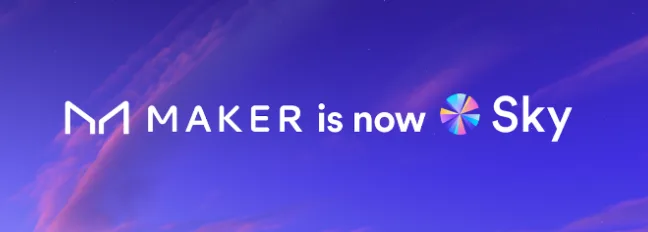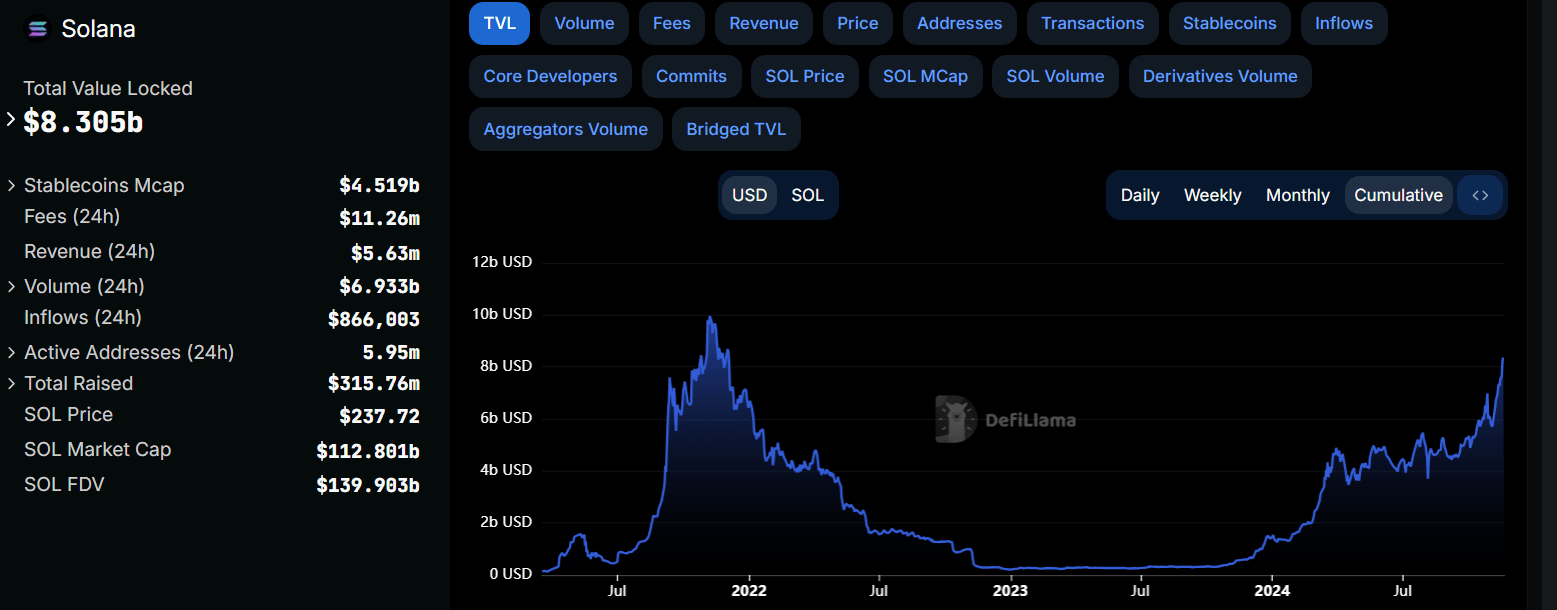Other stablecoins are also taking big steps to gain an edge in the very competitive market. PayPal expanded PYUSD's utility through a partnership with Xoom that allows cross-border payments in Asia and Africa. Paxos also announced plans to enter the EU market by acquiring Membrane Finance. Meanwhile, Flare introduced USDX, which is a Treasury-linked stablecoin that is designed to enhance liquidity and yield opportunities in DeFi.
Sky Taps Solana Ecosystem with USDS Launch
Sky, the decentralized finance (DeFi) protocol that was formerly known as Maker, deployed its USDS stablecoin on Solana to tap into the blockchain’s expanding DeFi ecosystem. The launch was announced on Nov. 19, and Sky’s USDS is the first major DeFi-native stablecoin on Solana.
This is just the beginning of Sky's strategy to enhance Solana’s DeFi liquidity and total value locked (TVL). The protocol also plans to introduce its SkyLink cross-chain bridge, pending governance approval, which will integrate USDS with its savings version, sUSDS.
USDS is a rebranded version of Maker’s Dai (DAI) stablecoin, which still maintains its peg to the US dollar. The rebranding to Sky in August, however, did cause some confusion in the community, which led to a proposal from co-founder Rune Christensen to revert to the Maker name. Despite this, the change is still in place after key stakeholders voted against taking on the original name.
Sky’s rebrand caused some other challenges as well, particularly with its governance token. The original Maker token (MKR) dropped in value after the rebrand and after the protocol encouraged holders to convert to the new SKY token. Adoption of the SKY token has been quite slow, partly due to its absence from exchange listings which is limiting its trading accessibility.

To try and attract Solana users, Sky is offering incentives for early adopters and liquidity providers on various DeFi platforms. On Kamino Finance, 200,000 USDS in weekly rewards will be available for USDC/USDS liquidity providers, with an additional 100,000 USDS allocated weekly for stablecoin suppliers. Drift Protocol users can earn 100,000 USDS in rewards for supplying the stablecoin, while Save Finance users will have access to a share of 400,000 USDS in monthly rewards.
Currently, USDS ranks as the third-largest stablecoin by market capitalization at $5.3 billion, and it holds a 2.8% share in a market that is largely dominated by Tether (USDT) and USD Coin (USDC).

Solana TVL growth (Source: DefiLlama)
Solana’s DeFi sector saw some remarkable growth this year as its TVL rose 400+% to reach $8.305 billion, according to DefiLlama. However, a lot of Solana's popularity has been fueled by the ease and affordability of launching meme coins on the network.
PayPal Expands PYUSD with Xoom
Other stablecoins are also going through some changes at the moment. PayPal expanded the use of its stablecoin, PayPal USD (PYUSD), by partnering with Xoom to enable cross-border payments in Asian and African markets.
The collaboration was announced on Nov. 19, and it will allow PayPal to settle transactions beyond traditional banking hours by broadening PYUSD's accessibility. Xoom teamed up with Cebuana Lhuillier and Yellow Card to facilitate the stablecoin's disbursements. The collaboration is also a big step in PayPal’s push to modernize payments infrastructure.
Yellow Card CEO Chris Maurice believes that stablecoins like PYUSD are transforming the payments landscape by making more efficient money transfers possible through advanced technology and stablecoin infrastructure.
PYUSD was launched in 2023 and is backed 1:1 by US dollars. It is issued by Paxos Trust Company, which is a regulated crypto custodian. The Ethereum-compatible ERC-20 token is the only stablecoin supported on PayPal's payment rails and is designed for integration with external developers, wallets, and Web3 applications.
In addition to its partnership with Xoom, PayPal has also been working with Anchorage Digital to offer rewards for clients who custody PYUSD and expanded PYUSD's blockchain presence by launching it on Solana earlier this year. Collaborations with Crypto.com, Phantom, and Paxos also made onboarding users to Solana much easier. Meanwhile, its partnership with MoonPay allowed PayPal users to buy cryptocurrency and access platforms like Polymarket.

Top stablecoins by market cap (Source: CoinMarketCap)
Despite these advancements, PYUSD still trails behind market leaders like USDT and USDC with their massive market caps. Other competitors, like Coinbase, incentivized stablecoin adoption by offering attractive annual percentage yields, like 5.2% for USDC. However, PayPal seems very committed to strengthening PYUSD’s ecosystem.
Paxos Enters EU Market with Membrane Finance Acquisition
Meanwhile, blockchain infrastructure platform and stablecoin issuer Paxos announced its agreement to acquire Membrane Finance, a Finnish Electronic Money Institution. This acquisition is still pending regulatory approval, but will grant Paxos entry into the European Union. This will make it possible for Paxos to operate as a fully licensed EMI in Finland and across 30 European countries under Membrane Finance’s Finnish Financial Supervisory Authority license.
Walter Hessert, Paxos’ head of strategy, believes stablecoins are playing a growing role in everyday transactions, and is excited about the opportunity to expand Paxos’ reach to European customers through this acquisition.
Membrane Finance is the issuer of the EUROe and eUSD stablecoins. The EUROe was launched in February of 2023, but has not seen much demand in a market that includes competitors like Stasis, Circle, Tether, and Celo.
Paxos established itself as a major player in the stablecoin market with its dollar-pegged Pax Dollar (USDP), which is regulated by the New York State Department of Financial Services, and gold-backed cryptocurrency (PAXG). It also launched the Lift Dollar (USDL), which is a yield-bearing stablecoin under Abu Dhabi Global Market regulation, and the Global Dollar (USDG), issued through Paxos Singapore in collaboration with DBS Bank and approved by the Singapore Monetary Authority.
This acquisition happened during evolving regulations in the European stablecoin market under the Markets in Crypto-Assets (MiCA) Regulation, which took effect on July 1. One day before Paxos’ announcement, Quantoz, a Dutch fintech firm, issued MiCA-compliant dollar (USDQ) and euro (EURQ) stablecoins with the support of Tether, Kraken, and Fabric Ventures under Dutch central bank approval.
Flare Launches USDX Stablecoin
DeFi is increasingly integrating with traditional finance (TradFi), which is exemplified by the emergence of Treasury-linked stablecoins like Tether’s USDt, Circle’s USDC, and the newly introduced USDX on the Flare Network. USDX is a native stablecoin on Flare, and is tied to U.S. Treasury yields and integrated into Flare’s FAsset system which offers real-world yields and enhanced liquidity for DeFi markets.
USDX plays a key role in Flare’s ecosystem as it provides advantages over bridged assets like USDC by enabling yields through platforms like Clearpool. Flare co-founder and CEO Hugo Philion explained that this makes the FAsset system more attractive for participants while still maintaining security through the Flare Time Series Oracle (FTSO), which ensures accurate pricing for USDX.
Despite criticism over delays in USDX’s launch, Philion was more focused on a methodical approach to building for the long-term crypto future, and placed more emphasis on sustainability and compliance. The Clearpool vault exclusively accepts USDX, and allows holders to stake the stablecoin for Treasury-linked yields.
Flare’s launch strategy for FAssets also adopts a conservative approach by initially limiting eligible collateral to reduce risks and manage growth effectively. By prioritizing gradual expansion and regulatory compliance, Flare wants to establish a secure and sustainable ecosystem for Treasury-linked stablecoins and cross-chain interoperability.
